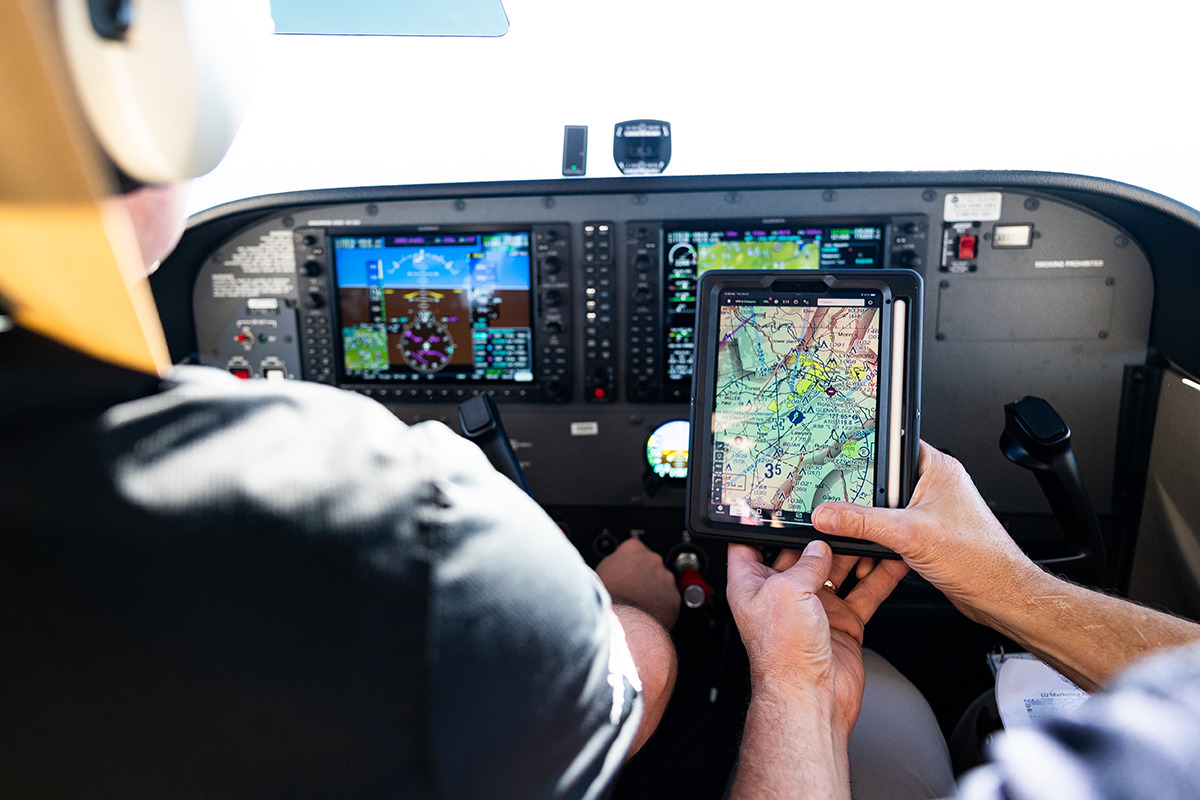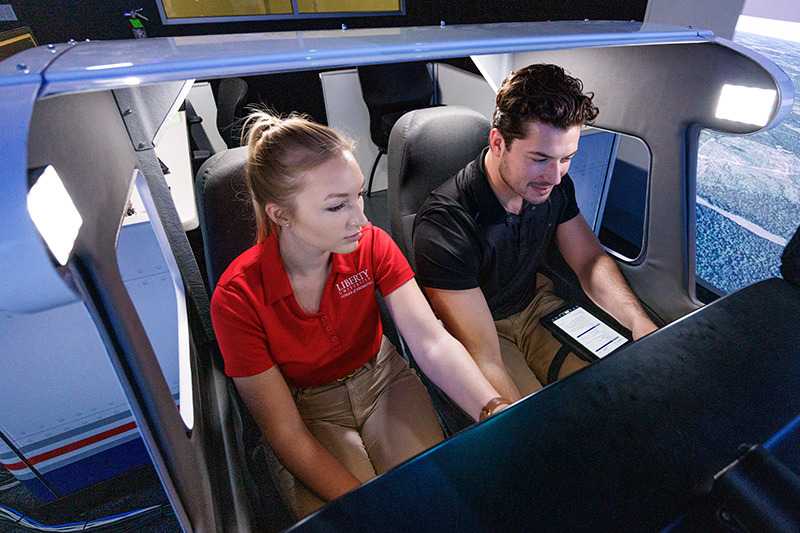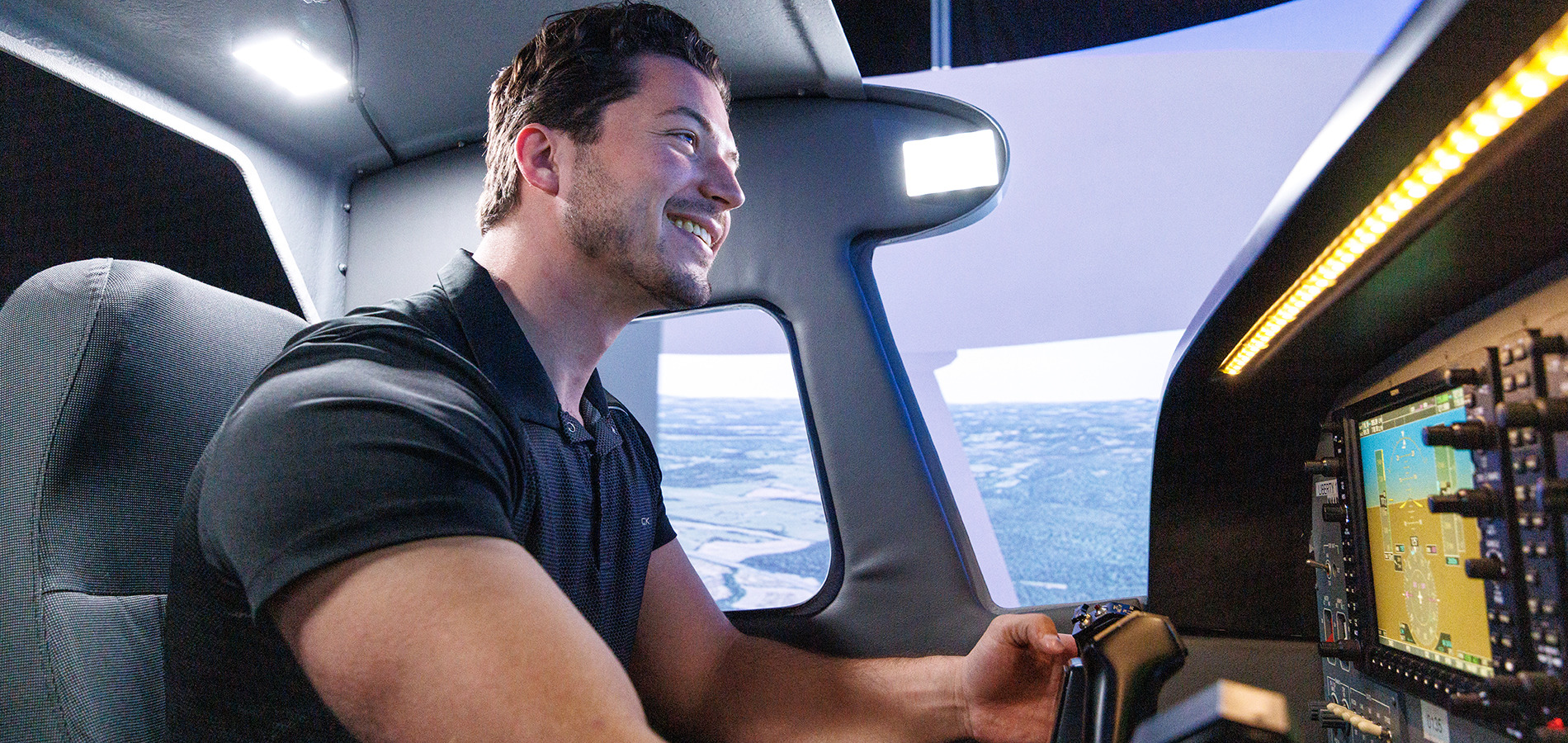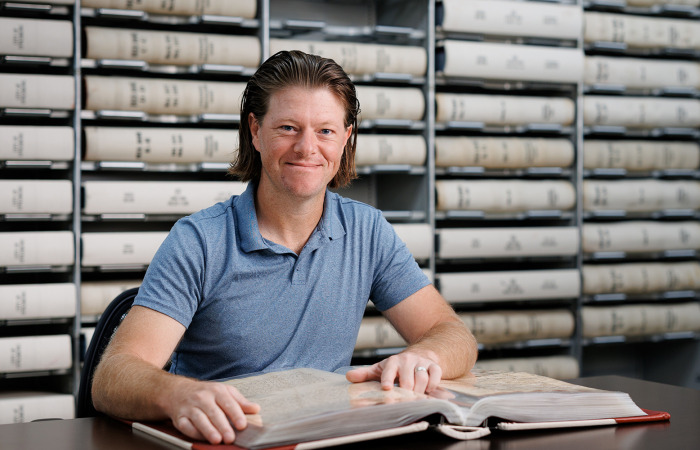School of Aeronautics staying ahead of flight training trends
Virtual reality, augmented reality, and artificial intelligence were once just buzzwords of the future. Now, this cutting-edge technology is becoming commonplace in our homes, workplaces, and the classroom. Liberty University School of Aeronautics is leading the way in using the latest technological advancements to transform pilot training as it sends out graduates well-prepared to meet the industry’s growing demands.
Integrating the new technology is a primary focus of Director of Technology and Innovations Kevin Martin, working out of the simulation center in DeMoss Hall and the university’s Center for Engineering Research & Education (CERE) aerospace labs.In the fall, Liberty became one of the first schools to connect its Electronic Flight Bags (EFBs) — tablets equipped with flight-data monitoring software — to its simulators (called flight-training devices, or FTDs), in addition to its fleet. The EFBs are outfitted with CloudAhoy, a post-flight debriefing program, and AirSync, a cloud-based service with immediate access to flight history data directly from the aircraft avionics.
“We’ve really done a system integration of aircraft and simulator. It’s all cloud-based,” Martin said. “Everything we do, technology wise, is focused on our students’ experience, whether it is with the virtual reality headsets or the artificial intelligence flight simulators, which allow students to learn how to fly before they ever get into the plane.”
Another app, ForeFlight, aids in flight planning and logging, with charts, weather and airport information, document management, and more. The apps are synced so they can provide a fluid, efficient system.

Electronic Flight Bag (EFB) tablets were introduced to the School of Aeronautics’ flight training operations at the start of the fall semester. (Photo by Matt Reynolds)
“This really takes our program to that major next step, being able to pull in all of that data,” Martin said.
The 90 EFBs are issued to all of Liberty’s flight instructors and specific flight professors, and the AirSync software is installed in its entire fleet of 27 aircraft (with two more on the way) as well as all of its FTDs.
Director of Flight Operations Ian Dutkus said with AirSync up and running, “we have been able to diagnose potential and reported aircraft issues more efficiently, returning aircraft to service at a higher efficiency rate. This efficiency has allowed us to operate a higher schedule effectiveness percentage to support the goal of overall student success.”
Both the aircraft and the simulators are also equipped with Garmin 1000 avionics, which provide pilots a wealth of flight-critical data on high-resolution screens.
“We can look at our entire fleet over time and start pulling those data analytics, which are extremely accurate because they are coming right from the airplane, to really ask what we need to do to train better, what we need to get smarter at,” Martin said. “I can pull the students’ flight information up on any computer to debrief on a nice big screen, enhancing the experience. Instead of trying to remember what you wrote down on your notes, it allows you to actually visualize it. Most pilots are hands-on, visual learners, so that really gives them that ability. It also helps us to correlate and transfer information faster, which at the end of the day saves them money.”
Students can also get hands-on practice with the school’s three Garmin G1000 tabletop trainers that replicate cockpit instruments.

Flight instructors and student pilots work in tandem in one of Liberty’s Flight Training Devices (FTDs) using an Electronic Flight Bag (EFB) tablet. (Photo by Chase Gyles)
Jonny Hewitt, director of flight training, said using the most advanced technology available has further standardized the debriefing process but also increased the overall learning process and the students’ performance.
“The ability to visualize and replay actual G1000 flight data after each flight and simulator lesson has changed the game entirely,” he said. “Our students now share a heightened awareness of their performance in flight, and that only continues to aid in their success throughout their training with LUSOA.”
Andrew Walton, director of safety for the School of Aeronautics, said the new technology is proving invaluable when it comes to safe flight training practices:
“The ability to detect engine anomalies immediately after each flight has a direct impact on safe operations. Additionally, we are working with the FAA to make it possible for Liberty and other flight schools to more quickly upload this data to a protected database where we look through aggregate data for safety trends.”
Another technology that has changed the trajectory of flight training is virtual reality.
“VR is the future of aviation training because it gives you the ability to have a more immersive experience,” Martin said. “We started researching VR and the associated hardware, and we’ve gotten very good at building systems that do flight sims in VR extremely well.”
VR is also being used to train airport management students by walking them through virtual layouts of Dulles (Va.) and Seattle-Tacoma (Wash.) international airports, using computer-generated imagery (CGI) viewed through a headset.
“The more we can trick the mind into believing it’s an experience in a simulation world, the more intensity and imprint you’re going to get, so the more correlation you’re going to have,” Martin said. “Now, with VR, the students get to actually walk around and experience it. Everything is geospatially correct, meaning if that particular item is 6 feet away in the software, you have to walk 6 feet to get to it. The mind sees that and does a really amazing job at correlating realism with it.”
Student-pilots also use robust VR systems at CERE, where the SOA has test beds for faculty, staff, students, and industry partners to research various new technologies. On campus, they have access to seven TakeFlight simulators equipped with AI technology, which Martin hopes to enhance with VR headsets this fall.
“TakeFlight is amazing because the artificial intelligence instructor is in there actually teaching you how to fly — how to start, how to taxi, how to take off, how to circle, climb, descend, turn — with no human interaction,” he said. “As you are flying, it’s talking to you, telling you what to do, giving you feedback, and you go through multiple lessons and you get graded on it based on the FAA standards. Those are no-cost, self-paced learning tools. Students can come in here and practice as much as they want to get good at it, and they do this before they ever hit a big sim, a flight instructor, or the airplane. This saves us a ton of time because they know how to taxi with their feet, which is something a lot of people struggle with.”
A VR system has also been added to the school’s UAS (Unmanned Aerial Systems, or more commonly called drones) simulator.
“Obviously, we want to build cutting-edge technology and we want to be able to use that, but expanding on this is going to expand our field of attracting more people here to this Christian university so they can go out into the world and spread the Gospel of Christ through this type of training,” said Brayden Johnson (’22), Liberty’s UAS operations coordinator.
Martin added, “That’s the goal, Training Champions for Christ.”




